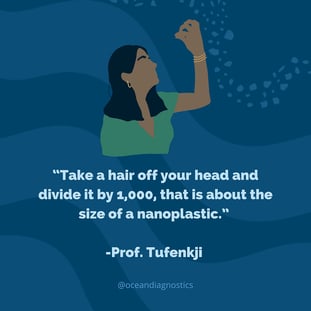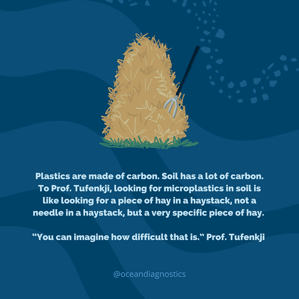How do Microplastics Enter the Environment?
Explore the mischievous ways microplastics flow into our environment through wastewater and how we can stop them at the source.
What are microplastics and nanoplastics?
Professor Nathalie Tufenkji defines microplastics as a diverse set of materials. “There are so many things that are microplastics. For example, when you drive your car down the road, the tire will wear and release small particles of tire and that is considered a microplastic. Your clothing that is made of potentially synthetic polymers such as polyester, acrylic and nylon can release small fibers and those are considered microplastics,” Prof. Tufenkji explains two common microplastics, but she says the list goes on.
Where do microplastics and nanoplastics come from?
Professor Tufenkji explains that microplastics and nanoplastics can sneak past wastewater treatment facilities and flow into the environment. Through different steps of water treatment some microplastics are removed, but not all.Do we contribute to the release of these particles in our day-to-day activities?
Chances are you do, but there is still time to make a change.What are the impacts of microplastics in the environment?
“We are not sure of the impacts, but it is clearly an undesirable scenario,” says Professor Tufenkji.
- How does the human body process these chemicals, particles and material?
- What is the potential effect of these diverse particles?
- How does shape and size influence their effects?
- Do the additives have different health effects?
- Do we just eliminate these microplastics when we go to the bathroom?
Microplastics are so diverse. These distinct types of plastics will likely induce different effects, making it difficult to determine their impacts.
“At the end of the day, reducing [microplastics] at the source is a priority,” says Prof. Tufenkji.

Canadian scientists work hard to pinpoint key sources of microplastic pollution, but there are challenges. “One of the challenges with plastics is that it is made of carbon. There is a lot of carbon in soil. When microplastics or nanoplastics are released into the environment, it is like looking for a piece of hay in a haystack. We are not looking for a needle in a haystack, we are looking for a very specific piece of hay. You can imagine how difficult that is."
Prof. Tufenkji explains, “When we have better techniques and technologies that allow us to detect microplastics and nanoplastics in different environments, then we can address some of these questions.”
What can we do right now to tackle microplastics in our homes?
“One, relatively easy thing to implement is to reduce the use of single-use plastics. You can just imagine the number of single-use plastic bags, the number of single-use bottles, single-use plastic cutlery and plastic wrapping. I think that is something Canadians can do now to help protect their own environment,” says Professor Tufenkji.
“We are moving in the right direction..." - Professor Tufenkji.
“We are moving in the right direction. There is a lot of research happening... In the next decade we are going to see the emergence of new materials and new technologies to help us deal with plastic pollution. We are also seeing a shift in customer behaviour and consumer interest in the problem. I am optimistic that we are going to see improvements with respect to scaling back plastic pollution.”
We are optimistic too, Professor Tufenkji!
Our team at Ocean Diagnostics develops revolutionary techniques and technologies to help scientists detect microplastics. Subscribe to our newsletter to receive updates on new microplastics technologies.
